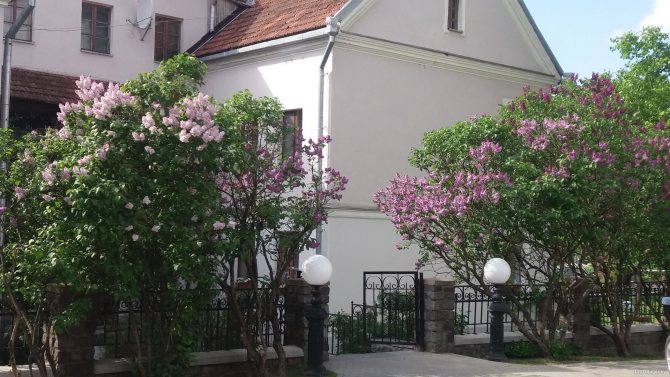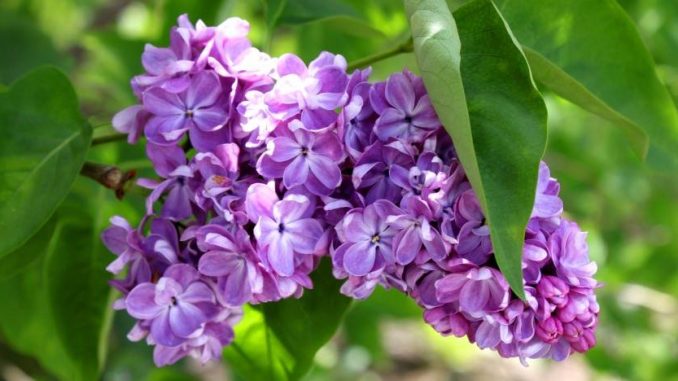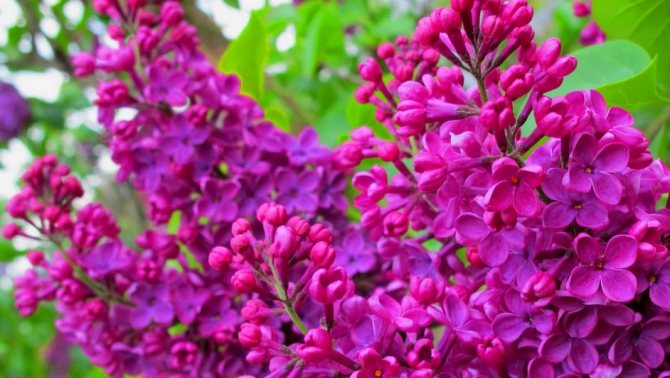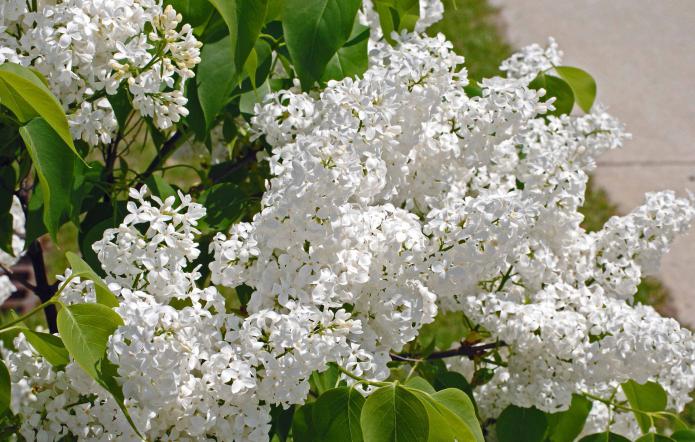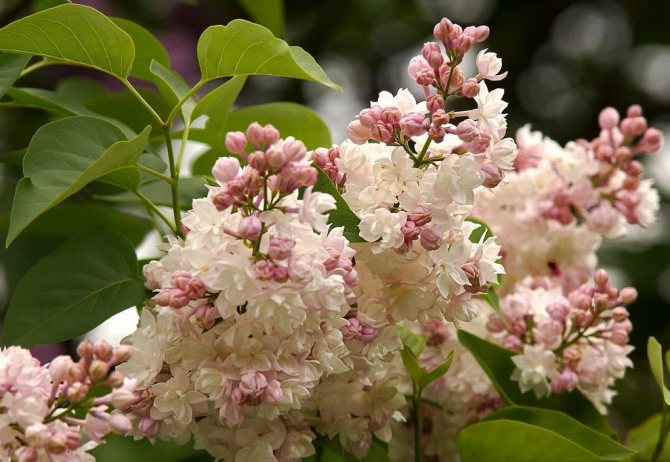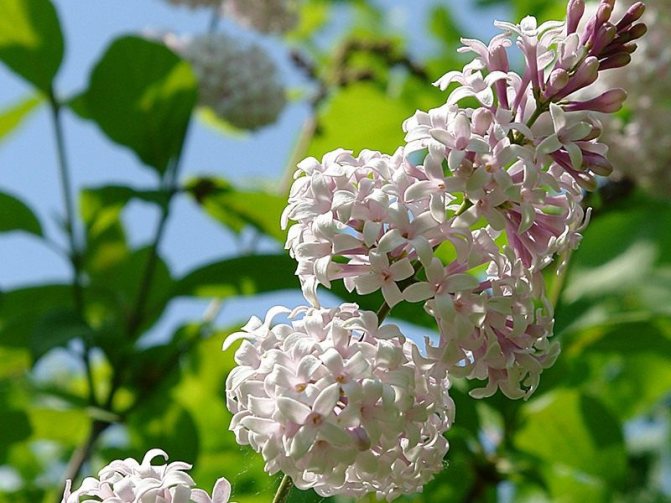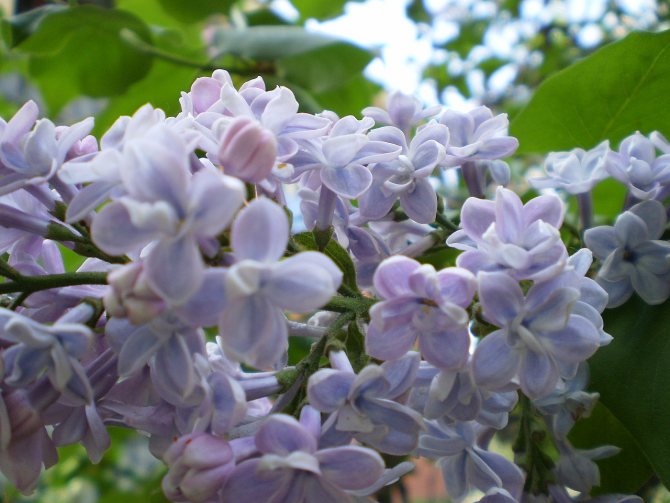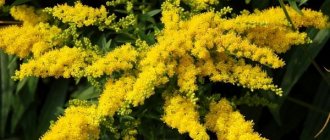
Lilac Hungarian
Lilac is an unpretentious shrub with unusually beautiful flowers of various colors. This plant feels great in any part of Russia, although there are varieties that cannot tolerate the cold, but you should not regret the inability to grow them in your garden, they are not so good.
For 150 years of breeding, more than 1600 different varieties of lilacs have been bred. In terms of the number of varieties, it is probably second only to roses and rhododendrons. Lilac varieties differ in shape, color and flower inflorescence. Simple, double, of a variety of colors and shades, these flowers do not leave anyone indifferent.
For ease of understanding, it is customary to divide the varieties of lilacs into color groups:
- Magenta (violet);
- Blue (all shades of blue);
- Pink (lilac pink, purplish pink);
- And of course - white.
Beauty of Moscow
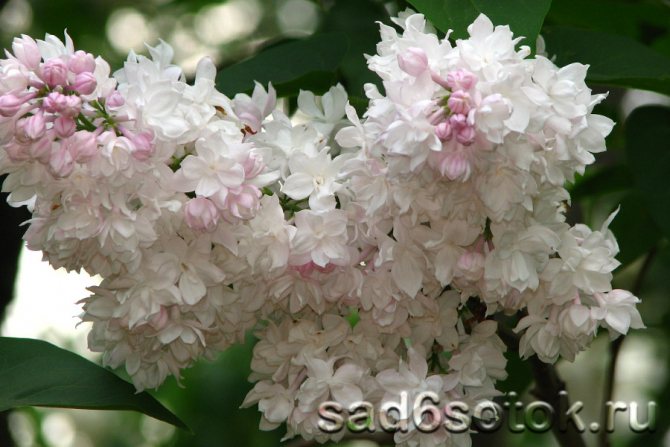

Beauty of Moscow
The height of the bush is 4 m, the width is 3 m. It blooms in late May - early June. The flowers are double, light pink, turning into white. Very aromatic. Inflorescences are dense panicles 25 cm high and 12 cm wide.
Lilac "Beauty of Moscow" was awarded the title "The most beautiful lilac in the world" and received the award "golden branch of lilac".
Flowers and reproduction
The flowering period of the shrub is in May-June. However, where the climate is warmer, it can start blooming as early as mid-April. Flowering and fruiting - from the 4th year of life. Flowers do not fall off for a long time, erect. Their color is very diverse: from rich lilac, violet shades to white.
Reproduction of common lilac occurs by root suckers or shoots from a stump. Under favorable natural conditions, seeds can germinate the next year, new specimens grow from them. Vegetative propagation is used to breed new hybrids.
The seedlings of the plant develop for a very long time, and only in the second year, when they get stronger, they can be planted in open ground.
Hippolyte Maringer


Hippolyte Maringer
Height - 2–2.5 m, width - no more than 2 m. Color - lilac-lilac, blooms in May, double flowers, having a helical shape. For abundant flowering, the shrub requires good care and rich soil.
Do not forget to cut off faded inflorescences to leafy shoots or to the first pair of developed buds of last year's shoot.
How to grow this bush correctly
Lilac is a plant that does not require complex care and does not present any particular difficulties. But nevertheless, it is better not to be lazy and take care of creating comfortable conditions.
At this stage, we can distinguish list of requirements, the observance of which will lead to a successful result:
Lighting
Lilac shrub - light-loving plant, requiring planting in a bright spacious area. Lack of light negatively affects the appearance, and postpones flowering until late, resulting in a sluggish and scanty appearance.
Temperature
The plant is resistant to frost, but categorically does not like strong through wind. The landing area should be positioned so that there is access to the sun, but no wind.


Lilac endures winter calmly, but drafts are destructive for it
Distance
The distance between the bushes is at least 2 meters.But if there is not enough territory on the garden plot, then dense planting of bushes is allowed only for hedgerows.
Transfer
They are transplanted mainly at the end of the summer season, before the onset of the first frosts. This period is optimal for transplanting greenhouse seedlings into a permanent habitat.
You can plant it in the spring, but the main thing is to have time before the kidneys wake up.
When the bush blooms, there can be no question of transplanting. Since in practice 60% of bushes die, and 40% postpone their flowering for several years in a row, even with regular maintenance.
Pruning
Faded brushes are cut off after flowering, this is due to the formation of flower buds on summer shoots. To replenish an old shrub with new branches, it is necessary to prune one branch at a time in the spring.
Top dressing
The first feeding is carried out during planting with mineral and organic fertilizers. After that, the plant does not need to be fed for about 2 years.
During active growth, it is necessary to spray the foliage with a mineral composition.
For good growth and lush flowering, it is necessary moderate soil moisture... When the plant begins to bloom, watering should be doubled, as the consumption of nutrients becomes greater.
Climate
The flowering shrub grows well in a temperate climatic zone, in which there are no sudden changes in temperature. But over time, bred hybrids appeared that withstand frosts with dignity.
The main thing to remember is that northern latitudes not ideal for growing the May Queen.
The soil
The soil composition for planting should be neutral. But if the soil is acidic on the site, then treatment with a known solution is necessary. Since this is a shrub plant, groundwater deposits should be at a level of 1.5 m.


The soil must be brought to neutral values.
The soil must be drained: shrub does not like stagnant water... Decay of the root system will completely destroy the plant. Lilacs do not grow in swampy, often flooded areas.
If there is no way out of this situation, the "beauty" is planted on a hilly surface or on a constructed alpine slide.
Lilac Hungarian
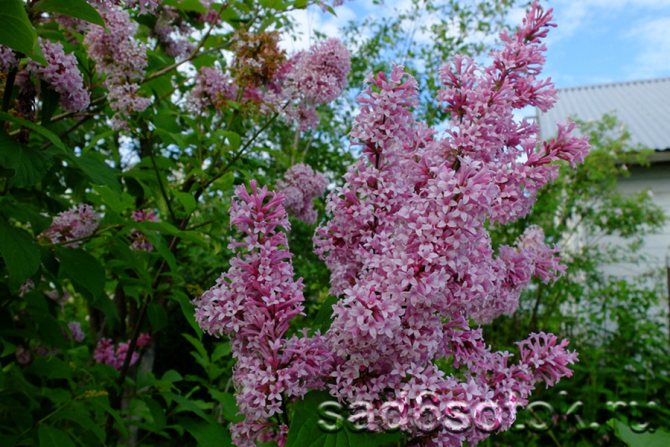

Lilac Hungarian
Height - 4 m, width - 3-4 m. It blooms approximately in June, panicle inflorescences are rather large, although the flowers themselves are small. The smell is faint, but pleasant. An unpretentious variety that feels great in urban conditions, frost-resistant.
A pleasant difference between the Hungarian lilac is that there is no root growth under it, which is so hateful to gardeners.
Lilac wood: physical and chemical characteristics, processing
Lilac wood belongs to the heartwood: sapwood is narrow, reddish or yellow, the core is red-brown, with purple veins. Lilac wood is characterized by a fine-grained structure with straight grains.
Lilac wood is very heavy (sometimes it sinks in water), with excellent physical and mechanical properties. Such characteristic of lilac wood as density is 0.85-0.98 kg / cubic meter, depending on humidity, terrain and variety of lilac. Also, this material is extremely wear-resistant, excellent polishing, grinding, cutting. It is a pleasure to work with it on a lathe: lilac wood allows you to create fancy small details. But this wood splits badly.
Lilac wood is a highly drying species... Therefore, if you notice deep cracks on the trunk, do not be sad, this is inevitable. A lot of cracks appear at the ends, but they are sawed off during the processing of the material.
Over time, lilac wood becomes covered with bright purple stains - this is the work of one of the specific mushrooms.In addition, after the work of mushrooms, such properties of lilac wood as extreme hardness and white color are manifested. After finishing - grinding, polishing - lilac wood looks very elegant.
Using hydrochloric or sulfuric acid, you can achieve a bright red color of the veins of lilac wood.


Amur lilac
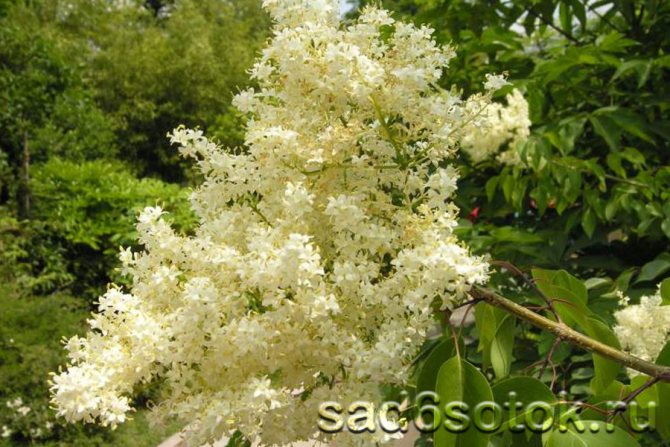

Amur lilac
Height - 10 m, width - 5 m. Winter-hardy shrub, flowering period occurs in late June - early July. The flowers are medium-sized, white-cream in color, with a pronounced smell of honey. The plant is gas- and dust-resistant, feels great in urban conditions, tolerates severe frosts.
Amur lilac is ideal for hedges, and also looks good in a group with other flowering shrubs.
Correct care
Common lilac requires not only proper planting, but also further care aimed at the dynamic development of the plant. The main actions are timely watering, regular feeding and pruning.
Watering
Watering should be abundant in the first half of summer. (up to 30 liters per 1 square meter). This is especially true in dry, hot weather. In the future, until autumn, watering is required only in the event of a persistent drought. Excessive watering at this time leads to the emergence of new shoots, which can freeze out in winter.
The first year watering is carried out only in the area of the planting pit. With an increase in the size of the bush, the watering zone is expanded.
Watering rates are determined by the location of the bushes. For example, a bush located in a sunny, well-ventilated place requires a larger volume of water, since under such conditions intense evaporation occurs.
In spring and summer, the crown is washed with a sprayed jet of water under pressure from a hose to remove dust and dirt accumulated from the top from the sheets at the lower levels.
Top dressing
To replenish the fertility of the soil on which the bushes grow, top dressing is carried out annually.
The first feeding is done in early spring, when the first young shoots appear. It includes mineral fertilizers, the amount of which is indicated for one bush:
- ammonium nitrate (20-30 g);
- superphosphate (30 g);
- potassium chloride (15-20 g).
The depth of application of mineral fertilizers into the soil by 10-15 cm is achieved by irrigation with plain water, to which slurry or mullein is added.
The second feeding will be needed in the middle of summer in the form of mineral fertilizers dissolved in 10 liters of water:
- ammonium nitrate (10-15 g);
- superphosphate (40-50 g);
- potassium chloride (25-30 g).
Pruning
If you do not prune, the height of common lilac can reach significant sizes: from 2 to 4 meters. At the summer cottage, such bushes will take up a lot of space, so every year you should remove young shoots, cut out shoots that grow below the branches of the main crown, weak and dry branches - this is how the crown is formed. The height of the plant is regulated over a period of several years, by pruning in the spring before the buds bloom, branches directed vertically along the growth. Lilac tolerates such pruning normally, constantly releasing new shoots.
Lilac is a small shrub or tree that has been cultivated by plant breeders in many countries since time immemorial. Lilacs owe their constant popularity in park and decorative ensembles to their amazing qualities.
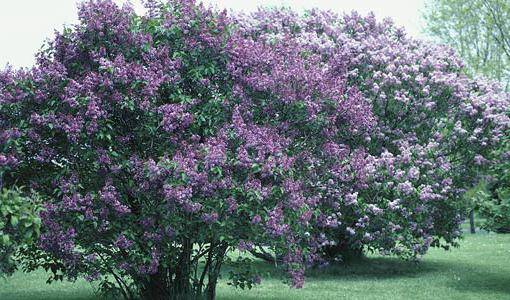

Beauty lilac
Beautifully shaped dark green leaves, amazing flowers shrouded in mysterious legends from different peoples, lush and long flowering, unpretentious care - all these are lilacs. This shrub or tree with lush inflorescences of purple, lilac, pink, red, yellow and white color withstands urban conditions well, feels great in shaded areas, multiplies easily, tolerates pruning well.Lilac flowers have a delicate aroma, and numerous varieties, bred by plant lovers over several hundred years, represent a wide range of shades of petal color and allow you to choose a shrub for almost any climatic zone.


A bit of history
The biological name of the plant in the classification (Syringa L.) refers us to Greece. The Greek word ‘Syrinx’ is translated as “tube”, which is associated with the shape of the flower. Another version is the origin of the name from the name of the ancient Greek nymph Syringa, who escaped from the god of the forests who was in love with her and turned into a bush, from which Pan later made a pipe. Lilac was first introduced into the culture of gardening in China, it was planted in Buddhist monasteries as a symbol of enlightenment. The ficus grown in India did not take root in the harsh climatic conditions of China, therefore, with the advancement of Buddhism to the north, lilacs also spread.
Is it a bush or a tree? The shape of the plant depends on the pruning. Despite this, according to the classification, lilac is a shrub. The free-growing wild species have many trunks, up to 8 meters in height. For decorative purposes, a lush bush of 5-15 trunks is usually formed, but some varieties are cut in the form of a tree.


Lilacs came to Europe in the 16th century along the Great Silk Road from Persia. Initially, the plant got to Austria, and from there it spread to other countries. The "Persian" lilac was not particularly beautiful, but firmly took its place in European culture. With the help of a branch of lilac, the girls refused to matchmaking to the gentlemen. The shrub grew in popularity after French breeder Victor Lemoine crossed the two plant species in 1870 to create an excellent hybrid. Over the next hundred years, the company, founded by the breeder, has developed more than 200 varieties of lilacs.
The shrub was brought to Russia in the middle of the 18th century. During the Soviet period, Leonid Kolesnikov made a great contribution to the breeding of the beauty. A simple gardener, he has been breeding new varieties for more than forty years. The state appreciated his achievements, and Kolesnikov was appointed director of the nursery. More than 300 varieties of lilacs have been bred under his leadership.
Biological characteristic
Lilac belongs to the genus of shrubs, the olive family. Its closest relatives are ash, privet and forsythia. From thermophilic relatives - olive and jasmine (the one that grows in southern countries). In the wild, the plant is found in the mountains of Europe (in the south), in China and in the Far East. There are about 30 species of this plant and many cultivars and hybrids.
Popular varieties of lilac
The following types of lilacs are widespread in Russia:
- Amur lilac. It is a shrub or tree up to 20 meters high, growing in the Far East and the forests of Northeast China. Flowers are white or creamy, small; blooms late. Resistant to frost.
- Hungarian lilac. This is a shrub or tree 4-7 meters tall, purple flowers, inflorescences are divided into tiers. Unpretentious to conditions, drought-resistant, garden forms of two types: pale purple and reddish flowers.
- Velvety lilac. Small compact shrub, native to Korea and North China. The flowers are lilac, with a white velvety cup; flowering is abundant, but shorter than that of other species (about 10 days).
- Persian lilac. Stunted, blooms later, long and abundantly. Sensitive to frost.
- Lilac Wolf.
Hybrid species: Henry Lilac, Hyacinth Lilac, Chinese. Hyacinth terry lilac looks very impressive. This is a tree or shrub, the photo is shown below.
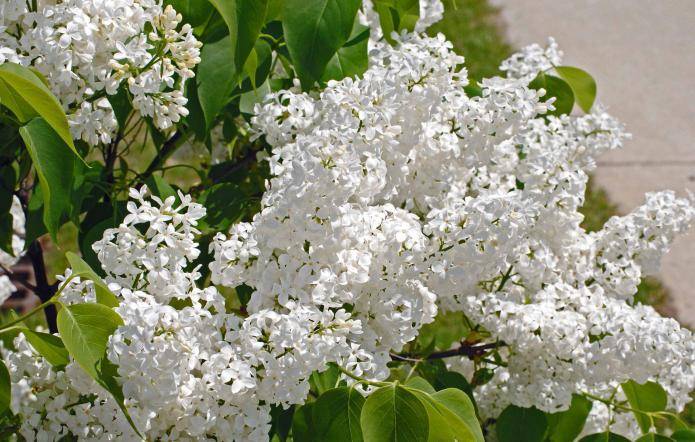

But the most popular among Russian plant breeders is common lilac. On its basis, many varieties have been bred: Primrose, Lights of Donbass, Dream, Congo, Cavour, Vestalka, Amethyst, Beauty of Moscow, terry varieties.The bushes are unpretentious to care for, they multiply well, grow quickly, bloom for a long time and luxuriantly, are resistant to the weather conditions of the middle zone.
Lilac is a tree or shrub
Galina Ulanova


Galina Ulanova
Large bush, spreading. It blooms very profusely, the inflorescences are creamy white, the flowers are simple pure white. With full flowering, the petals are slightly bent back. Flowering time falls in June - July. Loves sunny areas and partial shade.
Lilacs of the "Galina Ulanova" variety can be found not only in dachas near Moscow, but even in the garden of Buckingham Palace.
Bush or tree
In order to determine the generic affiliation of lilacs, you need to understand the basic concepts. The main feature of a tree is a single, well-developed, perennial trunk. The shrub is a woody plant, with stems extending from the base, which die off over time, but then are replaced by new ones.
Considering the listed characteristics, it can be confidently asserted that lilac is a shrub (it is also classified by plant guides, encyclopedias). Most often, the similarity with trees is explained by decorative pruning, however, there are a number of natural hybrids and specially bred varieties that differ from the classic species.
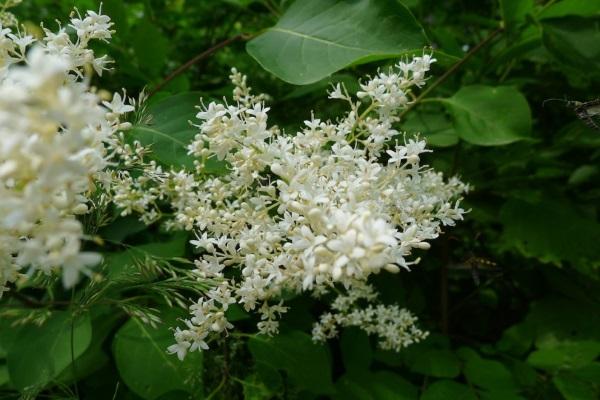

A striking example of an ambiguous classification is the Amur lilac. It reaches a height of 10 meters and is considered a multi-stem tree, because it has powerful, coarse stems. Despite its decent height, the Amur hybrid meets the lilac standards, which allows it to belong to this particular generic category. Some scientists believe that the plant should be classified in a separate group, but it still retains its status. Such cases give reason to supplement the general description with a vague wording: lilac is a bush, rarely a short tree.
There is another popular question: is lilac a flower or a shrub? In order to answer it correctly, you need to know that a flower is an organ of seed reproduction, the task of which is to form spores and gametes, and subsequently - a seed fruit. In everyday life, it is customary to call houseplants and flowering plants flowers, which is incorrect from the point of view of biology, but understandable in informal communication.
Olympiada Kolesnikov
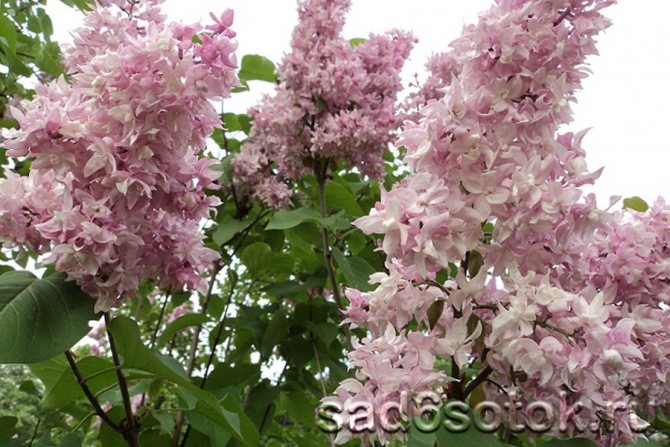

Olympiada Kolesnikov
One of the most beautiful varieties with pink-lilac double flowers 3 cm in diameter. The lower petals are strongly curved and oval in shape, while the upper petals become smaller and curl into the flower. Bushes are tall, more than 3 m, blooms for a long time and very abundantly.
The variety loves slightly acidic and neutral soils with humus content.
Description and varieties
Often amateur gardeners ask themselves: a lilac is a tree or a shrub. There is an unequivocal answer to it - lilac is deciduous shrub with many trunks, which grows from 2 to 8 meters in height with a trunk thickness of up to 20 cm, which is why many consider it a tree.
Lilacs are leafy in early spring and remain green until late autumn. In appearance, the leaves of different varieties have an elongated oval, ovoid, heart-shaped shape with a sharp top of light or dark green color. When flowering, conical panicles are formed, the length of which can reach 20 cm. The color of the inflorescences can be white, blue, lilac, violet, purple, and have pink shades. The flowers are small, bell-shaped, four-petal calyx, with a corolla, two stamens and a flat limb divided into four parts.
There are about 30 varieties of lilacs, which grow in personal plots, in gardens, parks and just outside.
The most suitable for growing in the country is common lilac which has been cultivated since 1583 and today is represented by four main varieties with the following description:
- "Red Moscow" - has purple-purple buds and blossoming fragrant flowers of a dark purple hue, about 2 centimeters in size;
- "Violet" - has been planted since 1916 as a variety with deep purple buds and double or semi-double light purple flowers, up to 3 cm in size;
- Primrose - lilac, which has light yellow flowers and greenish-yellow buds;
- "Belisent" - grows in the form of straight and tall bushes with slightly corrugated oval leaves and strong-smelling coral-pink inflorescences, about 30 cm in size.
If you want to grow something extraordinary in your summer cottage, you should consider the options as follows types of lilacs:
- Amur - a multi-stemmed shrub that can easily be mistaken for a tree, as it grows in nature up to 20 m high, and in culture up to 10 meters. Leaves, in color, when blooming in spring are painted in greenish-purple color, and in summer, when mature, they are dark green at the top and light green at the bottom. By autumn they turn purple or yellow-orange. Flowers smelling of honey, white or cream in color, are collected in large panicles up to 25 cm in size;
- Hungarian - a shrub that grows up to 7 meters, which has dark green shiny leaves with ciliate edges about 12 cm in size. Flowers are small, with a barely perceptible aroma, collected in panicles with division into tiers. The species is represented by two garden forms: red (red-purple flowers) and pale (pale purple flowers);
- persian - a hybrid of Afghan and small cut lilacs. It grows up to 3 meters in height and has dense and thin leaves up to 7.5 cm long, green in color. Fragrant flowers of light purple color are collected in wide panicles. In culture, the species is represented by three forms: dissected-leaved, white, red;
- chinese - a hybrid of common and Persian lilac, which was bred in 1777 in France. It grows up to 5 meters in height. It has 10 cm leaves and 2 cm flowers with a pleasant aroma, which are collected in panicles up to 10 cm in pyramidal shape. The most famous forms are: double (magenta color of flowers), pale purple, dark purple;
- hyacinth - the result of crossing common and broadleaf lilacs, which was carried out by Victor Lemoine in 1899. The leaves of the plant are dark green in color, heart-shaped or ovoid with a pointed top. In early autumn, they turn brown with a purple tint. The flowers are ordinary, but are grouped in small inflorescences. Represented by the following forms: "Esther Staley", "Churchill", "Puple Glory".
Pearl
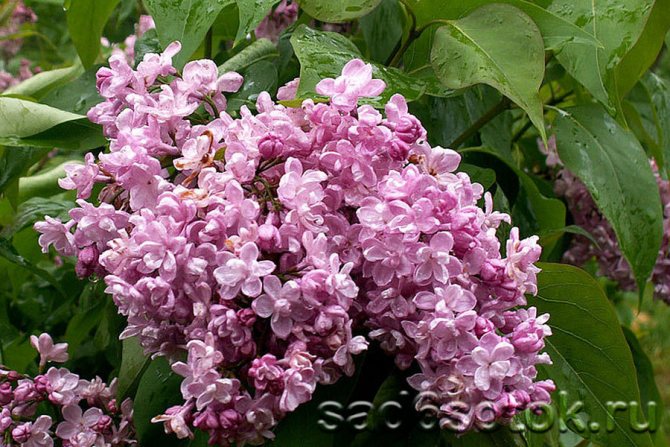

Pearl
A short but wide bush with dark green leaves. One of the early flowering varieties. The pink buds open into double mauve flowers. The preferred location is sun and partial shade.
Looks great in garden compositions. But you should choose areas with a low groundwater table.
Conditions for growth
When choosing a place for planting lilacs on your site the following parameters should be considered:
- intensity and duration of natural light;
- type and composition of soil;
- humidity;
- the size of the allocated area for the growth, development and nutrition of the plant.
In the temperate climate of the middle zone, lilac tolerates both hot summers and frosty winters.
Lighting and location
Lilac is an unpretentious plant, and he does not need special conditions. The most suitable place for planting it will be an area located on a plain or small slope with sunlight throughout the day. Bushes planted in the shade will not be lush, their development is slow, and flowering is very weak or absent altogether.
Bush soil
All are suitable for lilacs cultivated garden soils. Where fruit trees, berry bushes, ornamental plants grow, lilacs will feel good.
Do not fit her heavy structureless and highly acidic soils. Acidic soil is neutralized with lime, dolomite flour or ash, but this tool will have to be applied annually.
Temporarily flooded, swampy or lowland areas are not suitable for lilacs. In such landscapes, it is necessary to create a separate fill mound for each bush, and not a traditional pit, as in a conventional planting.
Problematic is also clay soil. But planting a plant is possible provided the planting site is loosened with sand, neutralized peat, leaf humus or other organic additives. But since clay does not allow moisture to pass through well, care should be taken that rainwater does not accumulate in the pit prepared for the growth of lilacs in such an area. Areas with high humidity are detrimental to this plant.
Victor Lemoine
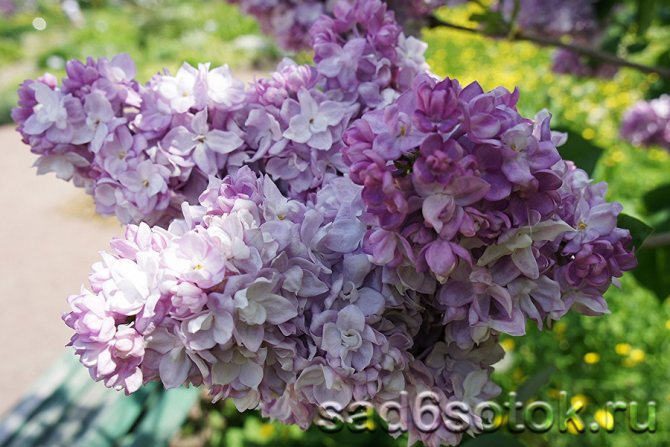

Victor Lemoine
The bush is quite high up to 4–5 m and 3–4 m wide. It blooms in May, not abundantly, but for a long time (about 20 days). Double flowers are light purple, buds are dark pink. Prefers slightly acidic and slightly alkaline soils.
Looks perfect in single plantings, alleys and tree and shrub compositions.
Practical application in medicine
Despite its toxicity, common lilac is a plant widely used as an analgesic and antimalarial agent. For these purposes, bush flowers are used. Leaves are used in the presence of purulent wounds.
In addition, lilacs are used in the treatment of:
- whooping cough;
- renal pathologies, mainly in combination with linden flowers;
- rheumatism;
- laryngitis;
- to improve visual acuity;
- pulmonary tuberculosis.
Lilacs are used as tea, tinctures, added to ointments.
Main types
The following plant species are common on the territory of Russia:
- Amur is a shrub of the Olive family, native to Manchuria. Varieties of this species are considered tall, as in adulthood they reach 10-12 m in height. During the late flowering period, in June, large cream-colored paniculate inflorescences up to 30 cm in length bloom on the crown. Exudes a pleasant honey aroma. Life expectancy is from 90 to 110 years.
The specific features of Meyer's lilac, Preston, small-leaved, Peking, drooping lilac are interesting. Despite the variety, shrubs are most often classified according to the color of the inflorescences. In accordance with the accepted typology, all plants of this class are divided into dark and light. Each of them has its own characteristics and preferences.
Video with a varietal overview.
Hyacinth lilac (Syringa hyacinthiflora)


It is a hybrid of common lilac and broadleaf. The plant blooms early - in early May. Some shrub varieties (eg Declaration) turn purple in autumn.
Popular varieties of hyacinthous lilac: Buffon (mauve flowers), Purple Glory (purple-purple flowers), Fantasy (purple buds, and the opened flowers are white-pink), Anabel (compact bush with double soft pink flowers).
Persian lilac (Syringa persica)
This lilac is very similar to common and Hungarian. It is also unpretentious, withstands drought, but in severe winters it can freeze slightly. The pink-lilac or white inflorescences of the plant exude a rich, specific aroma - not the same as in other species. Flowering is observed in the second half of May - June.
Persian lilac has an unusual shape with narrow cut leaves - Laciniata
North America
During the same period, the plant gains popularity in North America, breeders are engaged in the development of new varieties. In 1892, the famous specialist John Dunbar not only creates lilac hybrids, but also lays a garden in Rochester, which by the end of the 19th century became the venue for an annual thematic festival.Specialists in landscape design come here to this day.
Canada also did not stand aside: in the city of Hamilton there is the largest syringarium, which has about 800 copies of lilacs.
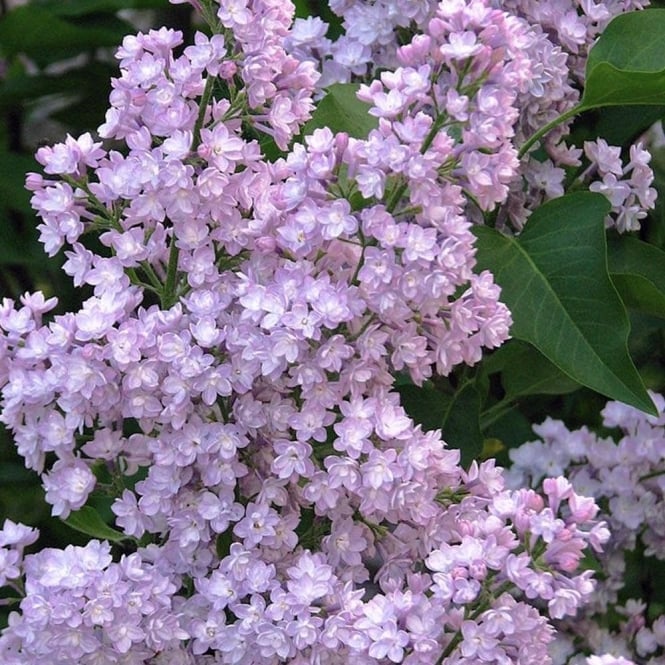

How to grow lilacs on a windowsill
On cold winter evenings, I really want to have a piece of spring at home. Lilacs just symbolize her arrival. If you wish, you can get a blooming twig of lilacs for the New Year's holiday, but for this you have to try.
To do this, in September-October, lilac shoots with a length of about 80 cm are cut off and packed in polyethylene, placed in a refrigerator, kept in a refrigerator for 4-5 weeks.
Important! The temperature should be -2-5 degrees.
After that, the shoots are dipped in a container of cold water for 10-12 hours. It remains only to place the shoots in a container of clean water in an upright position. Maintain optimal temperature conditions in the room:
- 1 week - 25 degrees;
- 2 week - 20 degrees;
- the next weeks - 18-20 degrees.
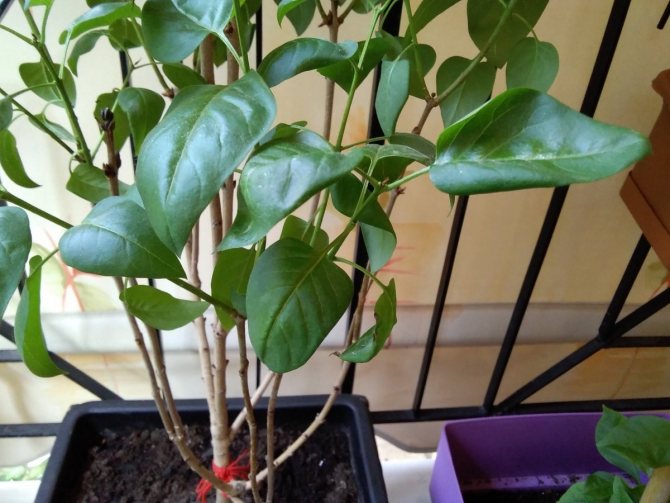

Grows at home
If all conditions are met, you can get blooming lilacs on the windowsill in 3-4 weeks.
Top 5 popular varieties
If there is a desire to acquire varietal shrubs on the garden plot, it is worth remembering that planting, care must be taken carefully, since they more demanding and finicky.
Each varietal lilac is beautiful in its own way, so before buying a shrub, it is better to inspect the top popular plants and decide on the choice.
Kiev woman
Highly popular variety, is in demand no less than the Beauty of Moscow. The flowers are blue, pink and lily-colored, have a delicate aroma.
Vestal
The shrub reaches five meters, blooms with large milky flowers. Long flowering is a characteristic feature of Vestal.
Congo
Ornamental shrub low size, about 2 m. This variety is preferred by landscape designers. It blooms in dense brushes, purple in color with a purple tint.
Beauty of Moscow
The most beautiful and extraordinary variety in the world. Such shrubs are scattered all over the world and are found on the territory of the US Congress, the Moscow Kremlin, Buckingham Palace.
Chameleon
Great variety, its buds purple lilac... Having blossomed, large, double flowers become pale blue with a purple border.
No less interesting are other varieties of this plant, worthy of a separate story. For example, we made a detailed description of the common Hungarian lilac variety.
Lilac: planting and care methods
Lilacs can be found as living curbs in parks and summer cottages. To prolong flowering and high-quality growth of a shrub, some rules should be taken into account when planting: It is better to use a composition with clay and sand with a low level of hydrogen as a soil.
The planting space should be illuminated and hidden from strong gusts of wind.


For planting, it is worth giving preference to elevated areas away from groundwater. When planting a group of seedlings, a distance of 2 meters between them should be maintained. The rule of this planting is also typical for the California lilac.
The dimensions of the hole for planting should be made in the form of a square, half a meter, and at the same depth. When using fertilizer products, the hole should be enlarged.
Choosing lilac seedlings
Particular attention should be paid to the quality of the seedling and the state of its root system, in a healthy plant they are strong, branched and well developed, with branching more than 0.3 m they should be cut off. Shoots should be checked for infected and damaged areas.


For good plant growth, weeds should be removed around the planting site, they take away nutrients from the plant, thereby blocking the access of oxygen.
How to choose the right period for planting lilacs
The planting period should be chosen based on the individual characteristics of the variety: some can be planted in spring or autumn, while others prefer the summer season.
Lilac planting rule
Drainage is placed in the planting hole, for which rubble, pebbles and other materials of this kind are used. We fill in the next layer with the soil, and place the root system of the seedling on it, then we fill it with the remaining soil until the hole is filled.


It should be noted that the peculiarity is that the roots should end up a couple of centimeters above the soil.
How much to water lilacs
Do not forget about watering the plant, but it is important not to overdo it, since the lilac does not like excess moisture. The beginning of summer should be considered a favorable time for abundant watering. On average, watering takes 25-30 l / m2, depending on the condition of the soil. At the onset of August, watering should be limited, increased only with the onset of drought.
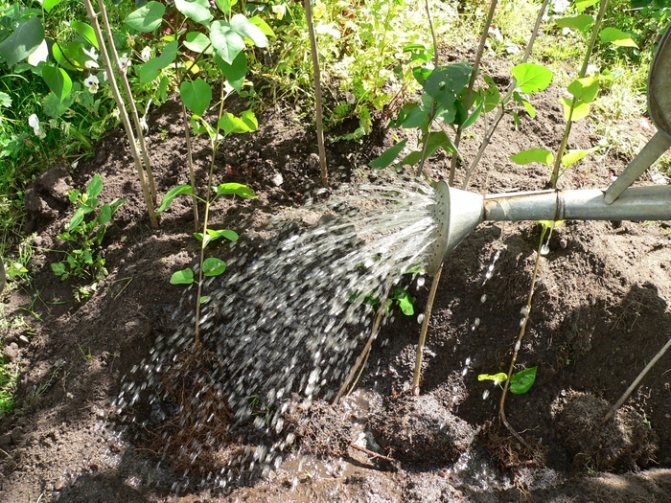

How to fertilize lilacs
For the qualitative development of the root system, the soil should be enriched with micro and macro elements, using fertilizers based on minerals and organic matter. It is worth paying attention to urea or ammonium nitrate, it promotes the formation of nitrogen necessary for growth.


For one seedling, 55-80 g of the drug should be allocated, it is recommended to fertilize during the growing season, in three stages. Vitamins are immersed in the soil around the root system to a depth of 8 centimeters. It is permissible to use phosphorus and potassium-based fertilizers. A good result can be obtained by alternating one and the other.
How to prune lilacs
Proper pruning of shoots - plays not only an aesthetic role, but will also have a fruitful effect on the development of the plant itself. Until the age of three, the bush does not need to be cut off, since it is not yet a fully formed organism. All subsequent years before the bud swelling on the tree, this procedure should be performed.


The main rule to remember is that no more than 8 healthy buds should remain on each shoot. Thanks to this procedure, during flowering, the plant is not overloaded. Old and lifeless branches should be regularly cut from the bush. All procedures must be performed with a sharpened instrument.
Landscape decoration


First of all, the shrub is used as a soil protection plant on slopes, which are often subject to erosion and erosion.
The shrub appeared in Europe in the 16th century; it was brought to Italy and Vienna from Turkey, where it was called "lilak". The introduced plant bloomed for the first time in 1589 in the Vienna Botanical Garden.
Until the 19th century, lilacs occupied a very modest place in landscape design. After all, the flowering period of a plant is very short, and not always regular. However, thanks to the efforts of breeder Victor Lemoine, everything changed after 1880. He managed to breed about ten varieties, some of which are still reference. The breeder received hybrids with luxurious lush flowers, with full inflorescences. Victor Lemoine also bred lilacs with terry petals in a variety of colors.
The breeder's son and grandson continued his work, and by 1960 the Victor Lemoine and Son nursery numbered 214 varieties and hybrids.
Since the beginning of the 20th century, breeding works have been carried out in France, Germany and Holland. The Dutchman Maarse made a huge contribution to obtaining new species. He bred 22 varieties, one of which is especially famous - Flora 1953, the diameter of the flowers of the common lilac of this variety reaches 3.5 centimeters.
Common lilac: description, classification
According to the shape of the flower, there are two categories:
- S, simple;
- D, terry.
Color standards:
| The code | Color |
| I | White |
| II | Purple |
| III | Blue |
| IV | Lilac |
| V | Pink |
| VI | Magenta |
| Vii | Purple |
| VIII | Difficult color, transitional |
Combined codes are also used, when the color of the flower falls into two or more categories, then the code is indicated through a slash. If the color changes during the flowering process, then the codes are written with a hyphen.

